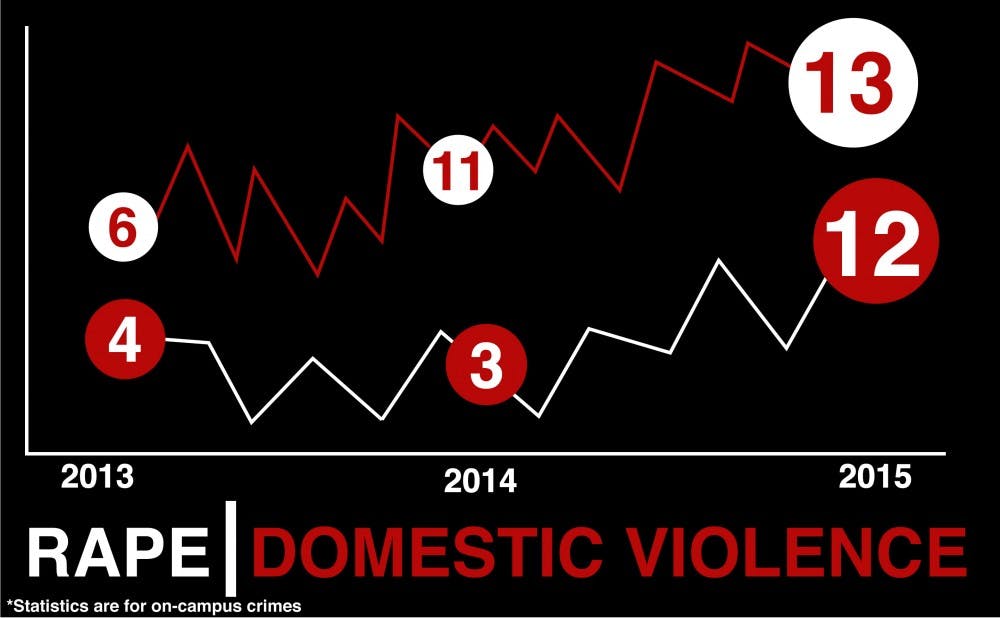The University’s newest annual crime report shows an increase in “Violence Against Women Act” crimes, but administrators said the data doesn’t tell the whole story.
The Jeanne Clery Disclosure of Campus Security Policy and Campus Crime Statistics Act—or the Clery Act—requires all universities to report certain crime statistics to students and employees. This year marks the third year the University is required to separately identify Violence Against Women Act offenses, and the data shows an increase in stalking and domestic violence.
At the same time, Vice President for Administration Kyle Cavanaugh said that by and large the report shows Duke to be a “very safe campus,” compared to others in North Carolina or nationwide. Similarly, he noted that reading too much into year-to-year fluctuations is not necessarily accurate.
“It’s difficult year after year to see if these are trends or just an aberration. For every one of those numbers, there is a story behind it,” he said. “I don’t take a lot of concern in one year over another being up by three, given how large we are.”
The report includes information from 2013, 2014 and 2015. According to the report, rapes on campus have increased to 13 in 2015 from 11 in 2014—however, there were six in 2013. In residential areas, the number jumped from five in 2013 to 10 for the past two years.
Within the VAWA category, incidents of stalking, including cyber-stalking, on campus increased from three in 2014 to 16 in 2015, and domestic violence from three in 2014 to 12 in 2015. Dating violence is up to five from one incident in 2013.
The Duke University Police Department compiles crime statistics by gathering data from reports to campus police, local police and other University departments, including the Office of Student Conduct.
Presented with the numbers, Cavanaugh said a statistical increase does not necessarily indicate that more such incidents are happening on campus. Rather, he said, it could indicate better outreach and more self-reporting, leading to “more accurate numbers.”
Figuring out the cause of the higher numbers is difficult to conclusively determine, he admitted.
As for the stalking and domestic violence upticks, he noted several caveats to the data. Most of the stalking cases involved employees and visitors, and most of them were cyber-related, he said. In addition, in most cases the victim knew the perpetrator, who was typically apprehended.
Cavanaugh noted that the police may not play a large role when the crime occurs between people who are familiar with each other.
“When two people know each other, it’s difficult to intervene and get in the middle of that,” he said. “This is one issue that we collectively own as a community. This can’t in any way be solely a police issue.”
At the same time, Cavanaugh insisted the University would not be taking anything for granted and would continue to find ways to mitigate crime.
In recent years, the University has increased its staffing of security guards and has worked to improve lighting and fencing on campus. Most importantly, Duke has installed about 800 security cameras during a several-year period, Cavanaugh said.
Although he declined to comment on exact locations—to not interfere with the cameras’ ability to detect crime—he noted that the University is planning on installing cameras outside East Campus residence halls. There are no plans to put cameras inside residence halls, Cavanaugh said.
The report also showed a decrease in burglary on campus from 51 in 2014 to 23 in 2013, although there was a slight increase in burglary incidents within residence areas, from eight to 13. Cavanaugh attributed the decrease to better communication, with students being warned to not prop open doors or leave them unlocked, for example.
Motor vehicle theft on campus increased from nine in 2014 to 18 in 2015, but Cavanaugh noted this was primarily due to unlocked scooters and bikes, not cars.
Lastly, liquor law and drug law violations have been steadily increasing the past three years. Liquor law violations on campus rose from 288 in 2013 to 372 in 2015, and drug law violations from 53 in 2013 to 100 in 2015.
Although the upward trend has been consistent, Cavanaugh said that this category—like others—could be due as much to better reporting as actual increases in criminal activity.
“I personally don’t have the sense that the utilization or practice [of drug and alcohol use] has increased significantly over the past couple of years,” he said.
Get The Chronicle straight to your inbox
Signup for our weekly newsletter. Cancel at any time.

